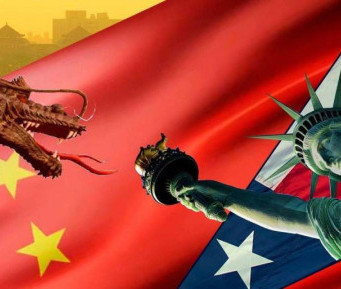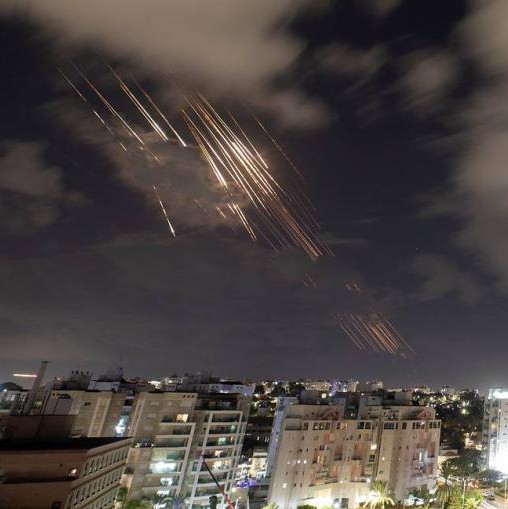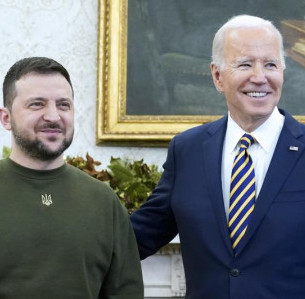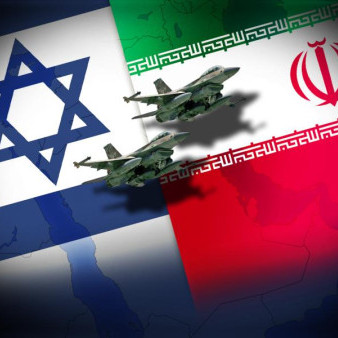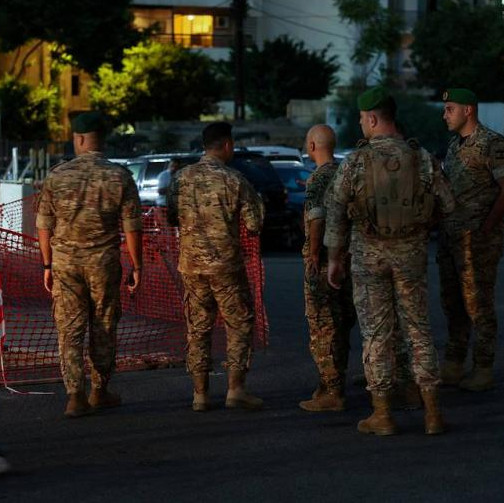It is primarily worth recollecting here, how the present-day nuclear club evolved. It was considered “elite” until very recently. The US first created nuclear weapons in the course of WWII, using it against Japan in 1945. The USSR was quick to respond to the US military threat by developing a nuclear bomb of its own by 1949. This apparently created a parity, which implied that the two nuclear opponents’ allies were also reliably protected. However, the first serious crisis showed that even a nuclear ally could abandon its partners for fear or for selfish reasons.
In 1956, Britain, France and Israel unleashed war against Egypt. Initially, they had some success: the English and French forces occupied the Suez Canal Zone, while the Israeli troops controlled the Sinai Peninsula. It seemed they needed just one more effort to take down Nasser. But on November 5, 1956 Nikita Khrushchev sent a “letter of friendship” to the British government. “How would England feel if stronger countries, armed with more advanced weapons, launched an offensive on it?” the letter read. “Nowadays, such countries would not even need to send their navies and air forces to the British Isles. They could use other means, missiles, for instance… Being deeply concerned about the current developments in the Near and Middle East, and for the sake of preservation of people in the world, we think that the British government must see reason and stop the war in Egypt. We appeal to you, to the parliament, to the Labour Party, to the trade unions and to the people of England: stop the military aggression, put an end to bloodshed. The war in Egypt can spread to other countries and grow into the Third World War.” And, to emphasize that he meant it, the Soviet leader added: “We are determined to use force to stop the aggression and restore peace in the Middle East.”
British Prime Minister Anthony Eden urgently appealed to the US, but received only an evasive response that the US government would strictly abide by its commitments under the North-Atlantic Pact. However, the Middle East was not part of the NATO influence sphere. Eden made several more attempts to contact President Dwight Eisenhower, but the latter was either out, or the US Department of State simply left Britain’s requests unanswered. The US made every effort to avoid meetings, and eventually Britain and France were forced to pull out of Egypt. The lesson was learned, and Britain started developing its own missiles to carry nuclear warheads created in London back in 1952, which were of course ineffective without a carrier. In 1960, France, too, provided itself with nuclear weapons.
In 1958, China, a USSR’s ally, found itself facing a similar situation. Mao was planning to occupy the Quemoy and Matsu Islands in the Taiwan Strait. Responding to China’s threats, Eisenhower publicly announced America could use nuclear weapons against China. No nuclear attack actually followed, but the Soviet government confirmed its military guarantees to China only when the US nuclear threat was over. History seemed to repeat itself; Beijing drew relevant conclusions, and by 1964 China was the first Asian nuclear power, and the last nation admitted to the “nuclear club,” with a “special” status. In the 1970s, China started it nuclear missile deployment which provided Beijing with regional predominance, while by the 1980s Chinese thermo-nuclear missiles had a sufficient range to reach the other nuclear club member countries. The Chinese government assumed that a nuclear conflict between the US an the USSR would inflict dramatic losses on both nations; in that case, China, having preserved its nuclear potential, could dictate its will to the winner. It did not even consider the possibility of a nuclear war against South Asian nations, because they posed no nuclear threat to Beijing at that time. Nuclear weapons were used as a means of political pressure on them, consolidating China’s position in regional tensions. Considering the high vulnerability of its nuclear potential, the Chinese government proclaimed the ‘no-first-use’ policy. In the early 1990s, however, China somewhat relaxed it, saying it could be the first to strike “preventively,” under the following emergencies: an unsuccessful borderline conflict fraught with a defeat of its main forces; a substantial loss of land with strategically important administrative-political centers and economic regions; a real threat of strategic nuclear forces destruction by conventional weapons, etc.
Given that China had a lot of territorial claims to its neighbors, this could not be left without attention. If China meant its nuclear weapons to be a minimal deterrent, its range would reach only the four other countries declared as nuclear powers. Such forces would only include CSS-3 and CSS-4 ballistic missiles. However, China was armed with shorter-range missiles as well – CSS-2 and CSS-5 missiles, the latter created after CSS-3 and CSS-4. It is important, because, with a range as short as 1,700 kilometers, it was obviously meant for hitting targets close to China. Such targets could include the conventional forces of nuclear powers or of countries bordering on China. Evidently, China’s nuclear policy was not as simple as it appeared, and it would not stop short of aiming nuclear strikes at its neighbors. Coupled with the growing might of the Chinese army and its de facto status as the second superpower, the apparent inability or unwillingness of external forces to defend its neighbors, created a powerful nuclear incentive along the perimeter of the Chinese border.
India was the first to react to the change in the distribution of forces. A new stage began in the long and deep-rooted Sino-Indian standoff. They had had disputed borderline areas totaling over 80,000 sq.km for years, with the tension reaching its peak after the 1959 Tibet events. The latter led to the October 20, 1962 conflict, when China actually attacked India. The Indian forces then failed to defend the Aksai Chin Plateau, which China claimed as a strategic territory.
India hoped for the USSR’s support, but was refused. So Nehru appealed to the United States instead. But before the US Air Force was deployed in India, China stopped the offensive and pulled out, holding out only on the occupied Aksai Chin Plateau. The incident eventually left India disappointed in the USSR as a reliable ally, and determined to rebuke China’s next provocation if it happens. In 1996, the conflicting sides agreed on mutual trust and reduction of armed forces in the border areas. Still, India regarded the ongoing Sino-Pakistani military cooperation as a threat to its security, which was only natural: in 1982, China provided Pakistan with a documents package for a ten-kiloton implosive nuclear bomb, which could be mounted on a ballistic missile. Pakistan was also provided with solid-fuelled theater ballistic missiles DF-11 with a 300-kilometer range and a payload of 800 kilos. In addition to the missiles and missile systems, Pakistan received manufacturing equipment and technologies, which means that today’s nuclear Pakistan is largely China’s work.
India staged its first military-purpose nuclear test on May 18, 1974, although Delhi claimed it was a “peaceful experiment.” Abiding by its official position in 1974-1988, India never recognized it had nuclear weapons or even plans to have it. In May 1988, however, India’s defense minister George Fernandes described China as “No.1 potential threat.” The nuclear test India ran eight days after his statement unambiguously looked like a response to China’s challenge. At present India is busy making nuclear-capable missiles with a range to reach China’s most important cities. The greatest hopes are pinned on the Agni-III ballistic missile. It was successfully test-fired in July 2006, which went practically unnoticed, as the international community’s attention was drawn to Korea’s tests.
North Korea has become another “nuclear neighbor” of late. The reasons behind it mostly have to do with the USA’s and Japan’s policies in that region, but the Chinese threat did play an important role, too. It does sound strange, China being North Korea’s key trade partner, financial donor and even military ally. The reality is more complex than that. China is actively interfering with North Korea’s internal affairs, which has essentially become an economic appendage of the north-eastern China. Beijing is exercising the greatest pressure on Korea’s government, lobbying against the dynastic transfer of power to the new totalitarian leader, trying to organize a pro-Chinese fifth column. The two countries’ mutual relations have not always been cloudless. In the 1960s, their old territorial controversy over Mount Paektu resumed, and borderline tensions aggravated because of frequent trespasses on both sides. And, as is generally known, protection may well lead to an intervention similar to Hungary of 1956 and Czechoslovakia of 1968.
A possibility is even discussed that China can absorb Korea in the future. China is already correcting history textbooks to lay a proper foundation for it. The Chinese Academy of Social Sciences has published a report explaining that the ancient kingdoms of the Korean Peninsula used to belong to China in the past. The conclusions made could later serve as a formal pretext for new territorial claims to North Korea (or the united Korea), which would be followed by the annexation of Korea to China as a “restoration of original Chinese lands.”
This past August, the world media quoted Kim Jong Ii as saying that Russia and China should not be trusted. One should understand that he has a good reason to make this statement. The recent six-nation talks in Beijing in fact turned into Sino-US bargaining and a trial of North Korea and Taiwan, with North Koreans present.
Pyongyang’s present nuclear status is tangibly limiting China’s options. After the nuclear test ran by Korea, changes started in Taiwan as well. Taiwan is a highly-developed nation with huge financial resources, yet it is “unrecognized.” Most countries, even maintaining economic contacts with the island, still refrain from its diplomatic recognition. Although Taiwan is protected by a set of US military guarantees, it now lacks the old confidence of America’s military assistance in case of a war with China. Taipei’s greatest fear is that the US could go back on their friendship in a critical situation. No US troops have been deployed on the island since 1979, and China plays an important role in the US economy. Anyway, it is hard to believe that the US president is prepared to use nuclear weapons against China, and lose 10 to 15 million Americans in a strike-back, to support a small island. That is why Taiwan’s government has been considering nuclear weapons of their own in the past few years, especially after October 9, 2006. Taiwan possesses both proper-range and proper-payload missiles to carry nuclear warheads, and the financial and scientific potentials needed to manufacture nuclear explosives. Even though Taiwan cannot covertly store enough fissile materials, it might consider an option of buying it. North Korea, in dire need of capital, could be easily inspired by Pakistan’s trade in nuclear technologies and materials (uranium hexafluoride), and start selling weapon-grade plutonium as well. It is also worth mentioning that Vietnam suddenly remembered to develop its nuclear energy sector after October 9.
It follows from the above that, after the cold war, three new nuclear nations emerged around China: Pakistan, India and North Korea. Interestingly, Pakistan acquired nuclear weapons thanks to China, while India and Korea, in spite of China. It appears that Taiwan could manufacture a nuclear bomb relatively fast, if it finds a way to procure enough plutonium. Being a special-status territory, Taiwan is free from the cumbersome system of nuclear commitments other nations have under the Nonproliferation Treaty and IAEA. Vietnam is now likely to start actively developing its civilian nuclear sector. If the regional situation changed, it would be ready to create its own nuclear weapons in the shortest possible time after the political decision is made.
In conclusion, one can assume with a high probability that the nonproliferation regime won’t work in the Asia-Pacific Region until the multiple regional conflicts are settled and while one or more regional players enjoy substantial military advantage and have nuclear weapons. The Nonproliferation Treaty will be acting as a discriminating system in the North-East Asia, simply securing the status-quo, until a system of full military guarantees and regional security agreements is in place. Nuclear powers’ hypocrisy does nothing but jeopardize the preservation of peace.
